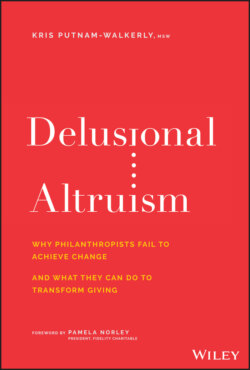Читать книгу Delusional Altruism - Kris Putnam-Walkerly - Страница 10
1 You Save Money on All the Wrong Things
ОглавлениеPhilanthropists like to save money, but they save it on the wrong things. Let me explain what I mean.
Foundation leaders, donors, professional athletes, corporate executives—all philanthropists—want to be good caretakers of their charitable wealth. They want their assets and profits to grow, so there's more wealth to give. They also want to reduce their charitable costs and save money, so there's more left over to give to the causes they care about.
All of this is well and good.
The trouble is, in their altruistic effort to be frugal, they hold back on investment in important things like talent, strategy development, research, evaluation, technology, relationship building, and even their own personal learning. They hold back investment in their grantees, too.
They do this by setting arbitrary limits on how much money can be spent on nonprofit “overhead,” or on when they expect to see grantees' results, but at the same time they refuse to fund evaluation costs. When they do this, they hamstring themselves and the nonprofits they support. They genuinely want their philanthropy to change the world, but they're under a misguided belief that saving leads to impact. They're delusional about the damage caused by their thrift.
Frugality rarely leads to social change.
This type of destructive frugality happens to all types of philanthropists. Let me give you a few examples:
The CEO of a foundation with more than $200 million in assets refused to allow his staff to take company laptops on business trips. Why? For what he felt was a good reason: He worried his staff would accidentally break or lose them, and he didn't want to spend $1,700 for each replacement machine. The problem, though, was that on business trips the staff couldn't get work done.
You might be wondering, “Why couldn't they use their smartphones instead?” This was in the early 2000s. Sure, they had cell phones back then, and even some early versions of smartphones like the BlackBerry. They weren't the powerful, multitasking microcomputers we today call smartphones. The problem for foundation staff was that without laptop computers, they couldn't make productive use of their time on airplanes or in hotel rooms. They couldn't prepare grant recommendations or research funding opportunities. Responding to emails was cumbersome. They certainly couldn't access the foundation's grants management system to review proposals. In other words, while they might have attended a useful conference, foundation staff got nothing else done for three days every time they made a business trip.
Why? The CEO didn't recognize that the value of investing in his employees' productivity far exceeded the unlikely expense of $1,700. With $200 million in assets and an annual grantmaking budget of $10 million, the laptop expense should not have been a concern.
Here's another example, from the grantee's perspective.
A nonprofit requested a three-year policy advocacy grant from a donor to advance an innovative approach to drug treatment. The donor, however, authorized a grant of only one year. But influencing public policy can require consistent effort over the course of years. Efforts include conducting research, raising public awareness, organizing residents, educating the media, and meeting with policymakers. It takes time.
Because the nonprofit lacked a realistic three-year funding commitment, its CEO couldn't hire top talent. The experienced person she wanted wouldn't leave her current job and risk her family's financial security for a one-year gig. The CEO ended up hiring someone who was less proven.
In the no-laptops-on-trips and one-year-of-money-instead-of-three examples, the funders saved money up front. But they did so at the cost of staff productivity and program expansion. They saved money on the wrong things. They were under the delusion that they were being good stewards of their philanthropic assets. Instead, they were getting in their own way.
Why does this happen? Part of the spell of delusional altruism is a scarcity mind-set. Yes, you read that right. Despite access to wealth, philanthropists live, work, and breathe with a scarcity mentality.
The scarcity mind-set happens to all philanthropists. It probably happens to you, too.
A scarcity mind-set is the misguided belief that a Spartan operation equates to delivering more value on the issues funders care about. It's a belief that, by not investing in their own capacity, talent, research, learning, strategy, technology, effectiveness, and infrastructure (or that of their grantees), funders can allocate more money to the causes they support and therefore achieve a greater impact.
Surprisingly, the scarcity mind-set has little to do with money. It has everything to do with belief.
Scarcity-minded donors believe that investment in their own operation is only warranted when the need is urgent. They limit their opportunities based on current capacity, not potential impact. Improvements they make, therefore, are only incremental. They feel they should always do more with less. In fact, they often believe they don't deserve what's best, fastest, or most efficient.
After advising ultra-high-net-worth donors and philanthropy leaders for more than 20 years, I believe this scarcity mentality is one of philanthropy's most detrimental self-created restraints.
The problem with a scarcity mentality is that it hinders your talent, stalls your creativity, and hijacks your opportunities to create systemic change. And it seeps into just about every aspect of philanthropic giving.
I realize you don't want to hear this. You don't want to be a glass-half-empty philanthropist! No one does. But read on. Part of what makes “delusional altruism” so delusional is that we get in our own way without realizing it. Let's learn about how we inadvertently allow a scarcity mentality to creep into our lives.
